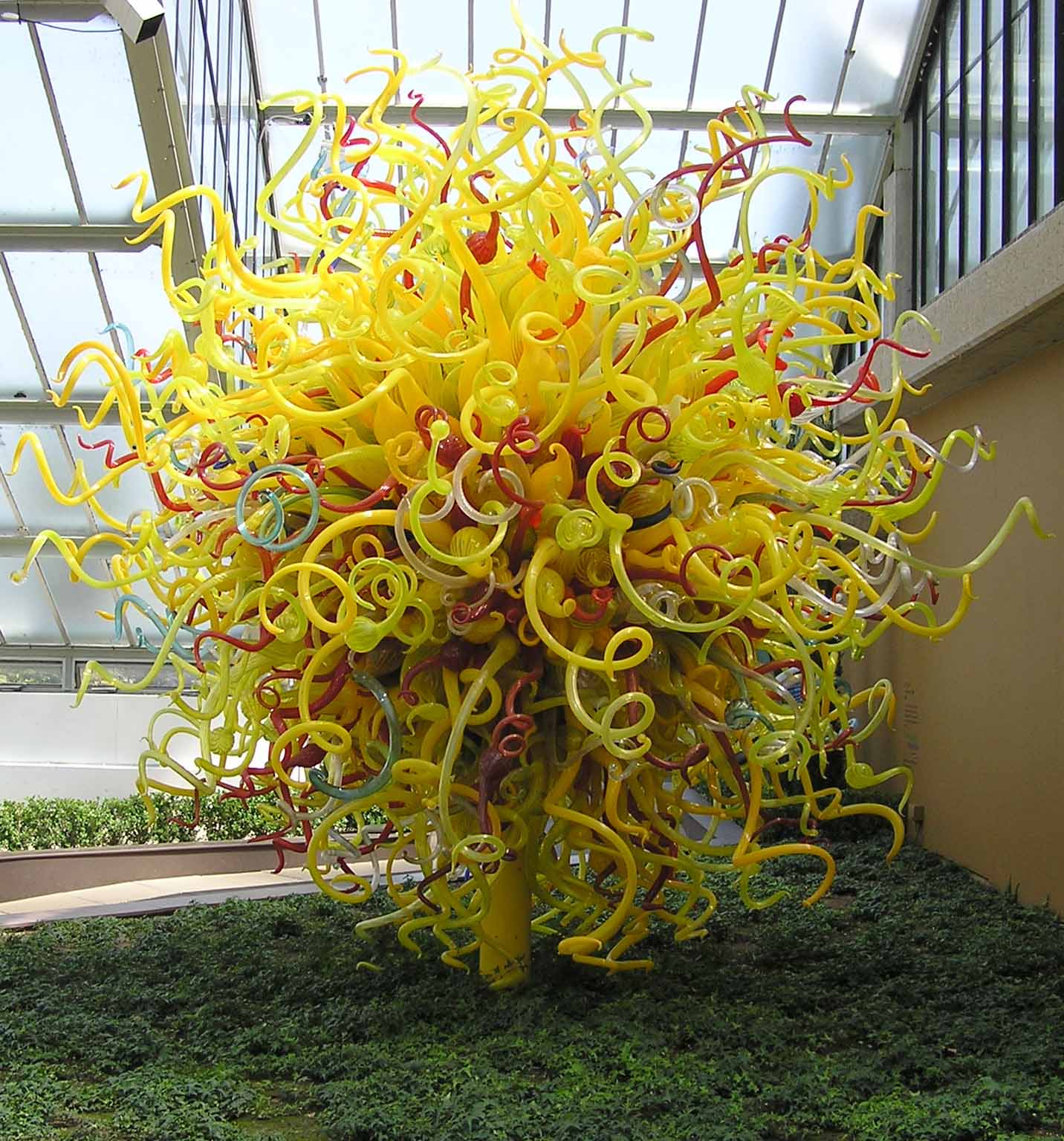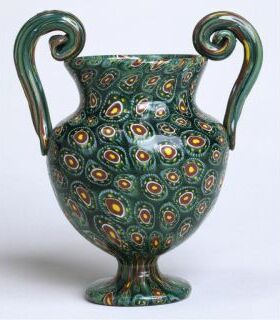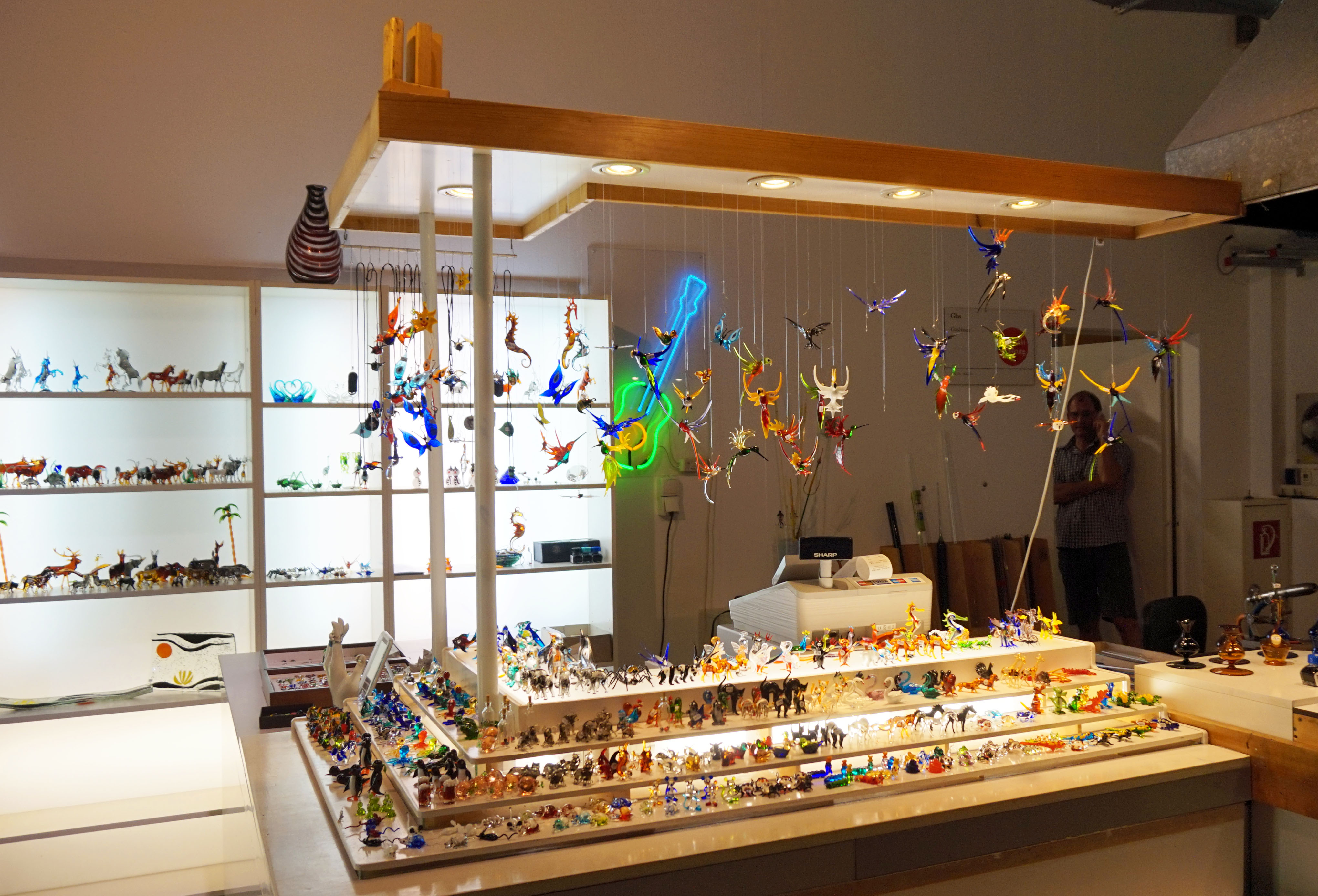|
Paperweight
A paperweight is a small solid object heavy enough, when placed on top of papers, to keep them from blowing away in a breeze or from moving under the strokes of a painting brush (as with Chinese calligraphy). While any object, such as a stone, can serve as a paperweight, decorative paperweights of metal, glass, jade or other material are also produced, either by individual artisans or factories. In the West, the decorative paperweights are usually in limited editions, and are collected as works of fine glass art, some of which are also exhibited in museums. First produced in about 1845, particularly in France, such decorative paperweights declined in popularity before undergoing a revival in the mid-twentieth century. Basic features Decorative glass paperweights have a flat or slightly concave base, usually polished but sometimes frosted, cut in one of several variations (e.g. star-cut bases have a multi-pointed star, while a diamond cut base has grooves cut in a criss-cros ... [...More Info...] [...Related Items...] OR: [Wikipedia] [Google] [Baidu] |
Paul Joseph Stankard
Paul Joseph Stankard (born April 7, 1943) is an American artist, flameworker (or ' lampworker') and author. Early life The second of nine children in an Irish Catholic family. Stankard lived in North Attleboro, Massachusetts, in his early years. In his autobiography, Stankard chronicles his early struggles with dyslexia, which made classroom learning difficult. His high school transcripts showed him graduating near the bottom of his class, mistakenly assigned a low IQ score. In the book, Stankard describes the pressure and stigma of being labeled a slow learner by an educational system that at the time was not aware of dyslexia. In 1972 he discovered the concept of dyslexia and started to develop a self-directed learning program that heavily relied on books on tape (audible books). His 50-year learning journey lead to two honorary doctorate degrees and allowed him to overcome his low self-esteem and learning disabilities to become one of the foremost glass artists of his genera ... [...More Info...] [...Related Items...] OR: [Wikipedia] [Google] [Baidu] |
Yelverton Paperweight Centre
Yelverton Paperweight Centre was a paperweight museum and supplier in Leg O'Mutton, a small hamlet near Yelverton, in the English county of Devon. The museum began as the private collection of a Cornish postmaster, and grew to contain over 1,200 items. It was featured in the humorous travel book, '' More Bollocks to Alton Towers'', which suggested that, "Even if you're sceptical when you arrive, you'll be amazed long before you leave". , the Paperweight Centre had closed and the building was up for sale. History The museum began as the private collection of Bernard Broughton, the postmaster of St Tudy in Cornwall. Broughton's wife was bequeathed a French paperweight in a family member's will, and this inspired Broughton to begin collecting paperweights. When his personal collection had grown, he began to open it for public viewings in his post office building. In 1978, Broughton moved to Yelverton and continued giving the public access to his collection. At the point of his dea ... [...More Info...] [...Related Items...] OR: [Wikipedia] [Google] [Baidu] |
Glass Art
Glass art refers to individual works of art that are substantially or wholly made of glass. It ranges in size from monumental works and installation pieces to wall hangings and windows, to works of art made in studios and factories, including glass jewelry and tableware. As a decorative and functional medium, glass was extensively developed in Ancient Egypt, Egypt and Assyria. Glassblowing was perhaps invented in the 1st century BC, and featured heavily in Roman glass, which was highly developed with forms such as the cage cup for a luxury market. Islamic glass was the most sophisticated of the early Middle Ages. Then the builders of the great Norman architecture, Norman and Gothic architecture, Gothic cathedrals of Europe took the art of glass to new heights with the use of stained glass windows as a major architectural and decorative element. Glass from Murano, in the Venetian Lagoon, (also known as Venetian glass) is the result of hundreds of years of refinement and inventi ... [...More Info...] [...Related Items...] OR: [Wikipedia] [Google] [Baidu] |
Chinese Calligraphy
Chinese calligraphy is the writing of Chinese characters as an art form, combining purely Visual arts, visual art and interpretation of the literary meaning. This type of expression has been widely practiced in China and has been generally held in high esteem across East Asia. Calligraphy is considered one of the four most-sought skills and hobbies of ancient Chinese literati, along with playing stringed musical instruments, the Go (game), board game "Go", and painting. There are some general standardizations of the various Chinese script styles, styles of calligraphy in this tradition. Chinese calligraphy and Ink wash painting, ink and wash painting are closely related: they are accomplished using similar tools and techniques, and have a long history of shared artistry. Distinguishing features of Chinese painting and calligraphy include an emphasis on motion charged with dynamic life. According to Stanley-Baker, "Calligraphy is sheer life experienced through energy in motion tha ... [...More Info...] [...Related Items...] OR: [Wikipedia] [Google] [Baidu] |
Baccarat (company)
Baccarat () is a French luxury house and manufacturer of fine crystal located in Baccarat, Meurthe-et-Moselle, France. The company owns two museums: the Musée Baccarat in Baccarat, and the Musée Baccarat in Paris on the Place des États-Unis. Groupe du Louvre was the majority shareholder of the company until 2005. The company was then acquired by Starwood Capital Group, which used the name for a luxury hotel called Baccarat Hotel New York, featuring the company's chandeliers, decorative pieces and glasses. In 2018, Fortune Fountain Capital, a Beijing-based financial group, acquired an 88.8 per cent stake of the company from Starwood Capital Group and L Catterton. On 23 December 2020, four financing funds based in Hong Kong - Tor Investment Management, Sammasan, Dolphin and Corbin - took control of the capital of Fortune Fountain Limited (FFL), the holding company that held 97% of the shares of Baccarat. History 1764–1816 After the closure of the Rozières saltwor ... [...More Info...] [...Related Items...] OR: [Wikipedia] [Google] [Baidu] |
Millefiori
Millefiori () is a glasswork technique which produces distinctive decorative patterns on glassware. The term millefiori is a combination of the Italian words "mille" (thousand) and "fiori" (flowers). Apsley Pellatt in his book ''Curiosities of Glass Making'' was the first to use the term "millefiori", which appeared in the ''Oxford English Dictionary The ''Oxford English Dictionary'' (''OED'') is the principal historical dictionary of the English language, published by Oxford University Press (OUP), a University of Oxford publishing house. The dictionary, which published its first editio ...'' in 1849; prior to that, the beads were called mosaic beads. While the use of this technique long precedes the term "millefiori", it is now most frequently associated with Venetian glassware. Since the late 1980s, the millefiori technique has been applied to polymer clay and other materials. As the polymer clay is quite pliable and does not need to be heated and reheated to fuse it, ... [...More Info...] [...Related Items...] OR: [Wikipedia] [Google] [Baidu] |
New England Glass Company
Libbey, Inc., (formerly Libbey Glass Company and New England Glass Company) is a glass production company headquartered in Toledo, Ohio. It was originally founded in 1818 in Cambridge, Massachusetts, as the ''New England Glass Company,'' before relocating to Ohio in 1888 and renaming to ''Libbey Glass Co''. After it was purchased in 1935, it operated as part of the Libbey-Owens-Ford company and as a division of the Owens-Illinois glass company until 1993, when it was separated back into an independent company. The company manufactures a number of glassware products, primarily tableware, drinkware and stemware. Historically, it was also involved in producing other types of glass products, such as automotive glass, glass drinking bottles, and light bulbs. History New England Glass Company (1818–1892) The New England Glass Company was originally founded in Cambridge, Massachusetts, by Amos Binney, Edmund Munroe, Daniel Hastings, and Deming Jarves on February 16, 1818. The com ... [...More Info...] [...Related Items...] OR: [Wikipedia] [Google] [Baidu] |
WheatonArts
Wheaton Arts and Cultural Center (formerly Wheaton Village) is a 501(c)(3) non-profit arts education organization, with a focus on the medium of glass. Located in Millville, New Jersey, the center's mission is to engage artists and audiences in an evolving exploration of creativity. Located on wooded in southern New Jersey, WheatonArts is home to the Museum of American Glass, the Creative Glass Fellowship Program that offers Artist Residencies, the largest folklife program in the Garden State, a hot glass studio, several traditional craft studios, five museum stores, a . event center and a pond-side picnic grove. In addition to daily glass blowing and craft demonstrations, WheatonArts features special exhibitions, programs, workshops, performances, and several weekend festivals throughout the year. WheatonArts hosts the Festival of Fine Craft yearly on the first full weekend in October. The organization was founded by Wheaton Glass, which was previously a major glass producer in ... [...More Info...] [...Related Items...] OR: [Wikipedia] [Google] [Baidu] |
Neenah, Wisconsin
Neenah ( ) is a city in Winnebago County, Wisconsin, United States. It is situated on the banks of Lake Winnebago, Little Lake Butte des Morts, and the Fox River (Green Bay tributary), Fox River approximately northeast of Oshkosh, Wisconsin, Oshkosh and southwest of Green Bay, Wisconsin, Green Bay. Neenah's population was 27,319 at the 2020 census. Neenah is within the geographic boundaries of the Neenah (town), Wisconsin, Town of Neenah, but is politically independent. The city is the southwesternmost of the Fox Cities of northeast Wisconsin. It is a principal city of the Oshkosh–Neenah metropolitan statistical area, which consists of all of Winnebago County and had 171,730 residents in 2020. It is sometimes referred to as a twin city with Menasha, Wisconsin, Menasha, with which it shares Doty Island (Wisconsin), Doty Island. History Neenah was named by Governor James Duane Doty from the Winnebago language, Hoocąk word for "water" or "running water". It was the site ... [...More Info...] [...Related Items...] OR: [Wikipedia] [Google] [Baidu] |
Art Institute Of Chicago
The Art Institute of Chicago, founded in 1879, is one of the oldest and largest art museums in the United States. The museum is based in the Art Institute of Chicago Building in Chicago's Grant Park (Chicago), Grant Park. Its collection, stewarded by 11 curatorial departments, includes works such as Georges Seurat's A Sunday Afternoon on the Island of La Grande Jatte, ''A Sunday on La Grande Jatte'', Pablo Picasso's ''The Old Guitarist'', Edward Hopper's ''Nighthawks (Hopper), Nighthawks'', and Grant Wood's ''American Gothic''. Its permanent collection of nearly 300,000 works of art is augmented by more than 30 special exhibitions mounted yearly that illuminate aspects of the collection and present curatorial and scientific research. As a research institution, the Art Institute also has a conservation and conservation science department, five conservation laboratories, and Ryerson & Burnham Libraries, Ryerson and Burnham Libraries, one of the nation's largest art history and ar ... [...More Info...] [...Related Items...] OR: [Wikipedia] [Google] [Baidu] |
Lampwork
Lampworking is a type of glasswork in which a torch or lamp is used to melt the glass. Once in a molten state, the glass is formed by blowing and shaping with tools and hand movements. It is also known as flameworking or torchworking, as the modern practice no longer uses oil-fueled lamps. Although lack of a precise definition for lampworking makes it difficult to determine when this technique was first developed, the earliest verifiable lampworked glass is probably a collection of beads thought to date to the fifth century BCE. Lampworking became widely practiced in Murano, Italy in the 14th century. As early as the 17th century, itinerant glassworkers demonstrated lampworking to the public. In the mid-19th century lampwork technique was extended to the production of paperweights, primarily in France, where it became a popular art form, still collected today. Lampworking differs from glassblowing in that glassblowing uses a furnace as the primary heat source, although torches a ... [...More Info...] [...Related Items...] OR: [Wikipedia] [Google] [Baidu] |
Cameo (carving)
Cameo () is a method of carving an object such as an engraved gem, item of jewellery or vessel. It nearly always features a raised (positive) relief image; contrast with intaglio, which has a negative image. Originally, and still in discussing historical work, cameo only referred to works where the relief image was of a contrasting colour to the background; this was achieved by carefully carving a piece of material with a flat plane where two contrasting colours met, removing all the first colour except for the image to leave a contrasting background. A variation of a carved cameo is a cameo incrustation (or sulphide). An artist, usually an engraver, carves a small portrait, then makes a cast from the carving, from which a ceramic type cameo is produced. This is then encased in a glass object, often a paperweight. These are very difficult to make but were popular from the late 18th century through the end of the 19th century. Originating in Bohemia, the finest examples were ... [...More Info...] [...Related Items...] OR: [Wikipedia] [Google] [Baidu] |








